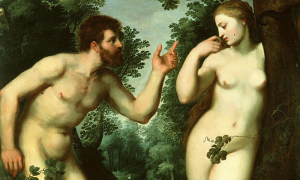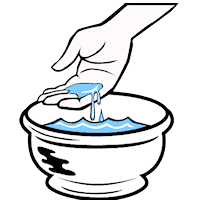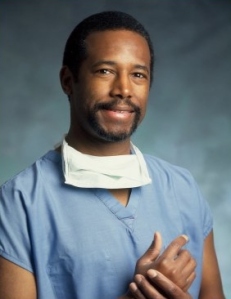
All Souls’ Day by Jakub Schikaneder, 1888. The painting shows an elderly woman after placing a wreath upon the tombstone of her loved one.
In the parish that I attend, an announcement was made that this year the congregation would be celebrating Halloween with something called “Truck or Treat.” I had never heard of this term. I know what Trick or Treat is, but “Trunk or Treat?” What is that?
So I went to the Internet for the definitive answer and here is what I found. A “Trunk or Treat” is a Halloween event that is often church – or community – sponsored. People gather and park their cars in a large parking lot. They open their trunks, or the backs of their vehicles, and decorate them. Then they pass out candy from their trunks. The event provides a safe family environment for trick or treat-ers.
Sounds innocuous enough, but one particular sentence caught my eye. It stated that Trunk or Treat was “a Christian alternative to Halloween.” A Christian alternative to Halloween? Really? Halloween is already a Christian festival. It does not need an alternative – Christian or otherwise.
Some Christians do not like any mention of Halloween – and they will make sure you know it. Christians love to argue about Halloween and while I cannot solve that dispute here on this blog post, I do want to challenge both sides to look at this festival and the issues surrounding it with a more open mind.
What is this holy day really about? For most ordinary people it is just a silly celebration where children have fun and we satirize things that normally make us uncomfortable. American culture does not have any real answer for death or demonic forces. So, Halloween is just one attempt to cope with those fears.
One weakness some Christians have is the tendency to become so focused on avoiding something potentially bad that they overcompensate and throw out too much of what is good – to “throw out the baby with the bath water,” to paraphrase Thomas Carlyle. Protestants in particular have a history of this. In their attempts to avoid what they have perceived to be “too Catholic,” they have no doubt stripped their worship experience and their theology of much that is good over the years. And their faith traditions are all the poorer for it.
Halloween is one such example.
Depending on whom one asks, Halloween probably falls somewhere between a harmless secular celebration on one end of the spectrum and a pagan or satanic holiday on the other. Most of us probably do not even think of it as a Christian holy day. But that is actually what it is.
The word Halloween (sometimes written Hallowe’en) is simply a contraction of All Hallows’ Evening. You may be familiar with the adjective hallowed, which means set apart or consecrated. The verb hallow means to make or set apart as holy. Hallow can also be a noun, and it means a holy person or a saint.
Where does Halloween fit into all of this? Traditionally feast days, such as All Saints, called for a day of preparation of heart and mind, in order to properly observe and celebrate the feast. Prayerful preparation preceded the holy day. That vigil became All Hallows’ Eve and originated from the Jewish practice of beginning days at sunset, not midnight, a practice that carried over into the early Christian Church. An earlier title for All Saints’ Day was All Hallows’ Day. The day before, then, is All Hallows’ Eve, which became Hallows E’en and finally Halloween.
That is where we get Halloween. Essentially it is another term for All Saints’ Eve, and that makes it pretty significant, because on 1November, All Saints’ Day is observed by many Christians as a major feast day. John Wesley, for instance, spoke of All Saints’ Day as “a festival I dearly love.” It is a day of celebrating the communion of saints, a community made up of all past, present and future Christians. 1
Halloween (31 October) and All Saints’ Day (1 November) are followed on 2 November by a third, lesser known day: All Souls’ Day. The combined three-day observance is called Allhallowtide.
What is the difference between All Saints’ and All Souls’, you may ask? Currently, there is not much difference because the two have been conflated over time and many churches do not even observe All Souls’ Day anymore. But the original purposes of the two days are quite different. Although the focus and purpose were quite different, the common theme of the dead was present in all three festivals. But All Saints’ Day is not just about those who have died.
All Saints’ is a day when Christians recognize those who have died, but it is also a day of asking how they, the living, should live as saints now and how they intend to pass on the faith to future generations of believers. That is what the Communion of Saints is all about.
In the New Testament, the word “saints” is used to describe the entire membership of the Christian community. From very early times, however, the word “saint” came to be applied primarily to persons of heroic sanctity, whose deeds were recalled with gratitude by later generations.
It is believed by many scholars that the commemoration of all the saints on 1 November originated in Ireland, spread from there to England, and then to the continent of Europe. There was the desire of Christian people to express the intercommunion of the living and the dead in the Body of Christ by a commemoration of those who, having professed faith in the living Christ in days past, had entered into the nearer presence of their Lord, and especially of those who had crowned their profession with heroic deaths.
Beginning in the tenth century, however, it became customary to set aside another day – “All Souls’ Day” – as a sort of extension of All Saints on which the Church remembered that vast body of the faithful who, though no less members of the company of the redeemed, are unknown in the wider fellowship of the Church. It was also a day for particular remembrance of family members and friends.
Though the observance of the day was abolished at the Reformation because of abuses connected with Masses for the dead, a renewed understanding of its meaning has led to a widespread acceptance of this commemoration among Anglicans, and to its inclusion as an optional observance in the calendar of the Episcopal Church as well as of several other Christian communities.
An eleventh century Benedictine abbot, Odilo of Cluny, fixed 2 November as a commemoration of “all the dead who have existed from the beginning of the world to the end of time.” All Souls’ Day spread as the Clunaic reforms spread through Benedictine monasteries into Western Christianity generally.
Nowadays, many American churches fuse All Saints’ Day and All Souls’ Day into one day and celebrate it on the Sunday following All Saints’ if 1 November does not fall on a Sunday. (This year it falls on a Sunday) Unfortunately, this practice has probably further separated Halloween from All Saints’ Day in the minds of many Christians.
Just as Santa Claus and the Easter Bunny have little to do with the real meaning of Christmas and Easter, so, too, a Darth Vader costume has virtually nothing to do with a true understanding of Halloween. The modern secular holiday of Halloween has been shaped by a number of factors, including paganism, Christianity and commercialism. (And the greatest of these is commercialism?) Because of Halloween’s association with death and evil, some Christians have avoided observing All Hallows’ Eve entirely. Others have attempted to Christianize the celebration of Halloween, which I find somewhat puzzling. How do you Christianize something that is technically already Christian?
Perhaps what is needed is to do something radical and return Halloween to its roots as an All Saints’ vigil. Contemporary society celebrates a Halloween void of any real meaning; it is fun, but it is empty fun. The church, however, possesses a Halloween full of meaning. It can become a hallowed evening again – a true Halloween. It is time to put the “Hallow” back in All Hallows’ Eve.





